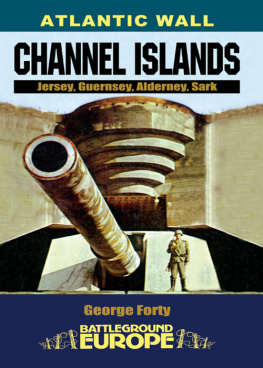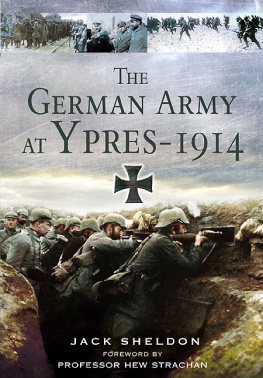Acknowledgements
When she found out I was writing another book, my younger daughter gave me a look that said it all. This book then turned into three. Sorry to everyone at home, and thanks.
As with previous books, a great big thank you to Anne Coulson for her help in checking the text and to The Prince Consorts Library for all their help.
Errors of omission or commission are mine alone.

Bibliography
Baer. C H. Der Vlkerkrieg Erster Band. Julius Hoffmann. 1914.
Baer. C H. Der Vlkerkrieg Zweiter Band. Julius Hoffmann. 1914.
Baer. C H. Der Vlkerkrieg Siebenter Band. Julius Hoffmann. 1916.
Baer. C H. Der Vlkerkrieg Zehnter Band. Julius Hoffmann. 1916.
Beckett, I.F.W. Ypres The first battle. Pearson, 2004.
Binding, R. A Fatalist at war. George Allen & Unwin. 1933.
Bull, S. German Assault troops of the First World War. Spellmount. 2007.
Chickering, R. Imperial Germany and the Great War, 19141918. Cambridge University Press, 2005.
Dewar, M. The First Flame Attacks. Volume 3 History of the First World War. Purnell, 1971.
Edmonds, Brigadier General Sir James, CB, CMG. Military Operations France & Belgium1914, volume 1. Macmillan & Co, 1922.
Edmonds, Brigadier General Sir James, CB, CMG. Military Operations France & Belgium1914, volume 2. Macmillan & Co, 1925.
Edmonds, Brigadier General Sir James, CB, CMG. Military Operations France & Belgium 1915, volume 1. Macmillan & Co, 1927.
Foley, R. German strategy and the path to Verdun. Cambridge University Press. 2005.
Grlitz, W(ed). The Kaiser and his court (the First World War diaries of Admiral Georg von Mller). Macdonald. 1961.
Gray, R & Argyle, C. Chronicle of the First World War Volume 1, 1914 1916. Facts on File, 1991.
Gray, R & Argyle, C. Chronicle of the First World War Volume 2, 1917 1921. Facts on File, 1991.
Hedin, S. With the German Armies in the West. John Lane. 1915.
Herwig, H. The First World War, Germany and Austria 19141918. Arnold, Headline Group. 1997.
Hlcher, G. Geschichte des Weltkriegs Erster Band. Hoursch & Bechstedt. 1915.
http://en.wikipedia.org/wiki/Albrecht,_Duke_of_Wrttemberg
http://www.wwiaviation.com/float-planes_central_powers.html
http://home.comcast.net/~jcviser/aka/emmich.htm
http://www.firstworldwar.com/battles/haelen.htm
http://www.firstworldwar.com/battles/louvain.htm
http://www.greatwar.co.uk/ypres-salient/battles-ypres-salient.htm
http://www.historyonthenet.com/WW1/trenches.htm
http://www.landships.freeservers.com/ww1_hmgs.htm
http://pictureshistory.blogspot.com/2009/12/neutral-netherlands-holland-during-ww1.html
Humphries, M O & Maker, J. (editors) Germanys Western Front: Translations from the German Official History of the Great War. Wilfrid Laurier University Press, 2010.
Ludendorff, General. My War Memories 19141918 volume 1. Hutchinson (No Date) Macdonald, L. The death of innocence. Headline. 1993.
Michelin & Cie. Ypres and the battles for Ypres 19141918. Michelin & Cie. 1920.
Nash, D.B. Imperial German Army Handbook. Ian Allan. 1980.
Palmer, S & Wallis, S. A War in Words. Simon & Schuster. 2003.
Passingham, I. All the Kaisers Men. Sutton Publishing. 2003.
Poseck, M von. The German Cavalry. E S Mittler & Son. 1923.
Roynon, G. Massacre of The Innocents The Crofton Diaries, Ypres 191415. Sutton Publishing. 2004.
Scheer, Admiral R. Germanys High Sea Fleet in the World War. Cassel & Co. 1920.
Schwink, O. Ypres, 1914 (The Battle on the Yser and of Ypres in the Autumn 1914). Constable. 1919
Sheldon, J. The German Army at Ypres 1914. Pen & Sword. 2010.
Sulzbach, H. With the German guns. Leo Cooper. 1973
The Times. Documentary History of the War. Volume 8. The Times Publishing Company. 1919
Thoumin, R. The First World War. Secker & Warburg. 1963.
Tichischwitz, E von. Schlachten des Weltkrieges Antwerpen 1914. Gerhard Stalling. 1925.
Unknown. Battles of the Ypres Salient. The Great War 19141918.
Wegener, G. Der Wall von Eisen und Feuer Ein Jahr an der Westfront. F A Brockhaus. 1915
Weintraub, S. The remarkable Christmas truce of 1914. Simon & Schuster. 2002.
Westman, S. Surgeon with the Kaisers Army. William Kimber. 1968.
Williams, J.F. Corporal Hitler and the Great War 1914 1918. Frank Cass. 2005.
Witkop, P (Ed.). German students war letters. Pine Street Books. 2002 www.19141918.net/bat1.htm The Battle of Mons
Young, Brigadier P. The Great Retreat. Volume 1, History of the First World War. Purnell. 1969.
Zuber, T. The Mons Myth. The History Press, 2010.

1914 The Advance through Belgium
On 25 July the Austro-Hungarian populace were informed of the partial mobilisation of the army and Landsturm. By the end of the month Emperor Wilhelm had stated in an Imperial Ordnance that, apart from Bavaria, the German Empire was in a condition of war. This was not a state of war but a warning to the country that there could be a war. The next day the Emperor mobilised the army and Navy making 2 August the first day of mobilisation. Then, informing the German people that the country was being forced into war, he called upon all who were capable of bearing arms to defend the Fatherland.
At the beginning of the war the intentions of the French and Russians were unknown; the worst scenario was a more-or-less coordinated Franco-Russian attack. In the east, even facing only active service troops, the odds would be two to one in favour of the Russians, and the arrival of Far Eastern units and the reserves would lengthen the odds considerably. The Austro-Hungarians would also be in the same position.

Posted a year after the war started; a patriotic card sold on behalf of the Red Cross. For Emperor and Empire reads the banner.
Intelligence was aware of the Franco-Russian agreement to launch simultaneous attacks on the fifteenth day of mobilisation. As Russia had begun its mobilisation on 30 July this joint attack would be on 14 August. Troops would have to be transferred to the east by day thirteen of Russian mobilisation.
While Austria and Germany prepared and mobilised, so too did the armies of France, Russia, Belgium and Britain. On 2 August, the French accused the Germans of crossing the frontier at three different points, shooting at the border personnel, stealing horses and killing a soldier. The next day, the German Ambassador in France, in his farewell letter, accused the French of violating Belgian territory and dropping bombs on Germany, giving his reason for leaving as the state of war that now existed between France and Germany. The die was cast Europe would go to war.
Over 11,000 trains carried the army to the offensive. In just over two weeks 2,150 trains crossed the Hohenzollern Bridge in Cologne a train every ten minutes. Nearly four million men were mobilised, assembled and deployed, along with 850,000 horses.

The easy way to arrive. A troop train arriving in Belgium in October 1914.
Even before mobilisation had officially started, 16 Infantry Division had moved into Luxembourg. A belated call from the Kaiser failed to halt the attack which was already underway by one company. By then, Lt. Feldmann and his men had successfully taken their objective, Troisvierges station, without control of which it would be more difficult for troops to access France. As a result, the next day,
Next page




















